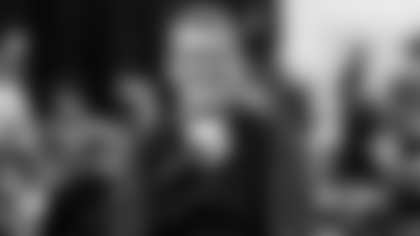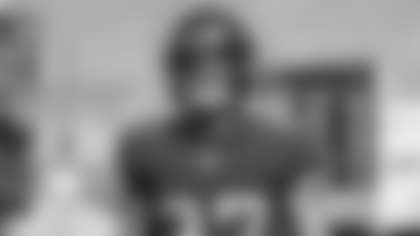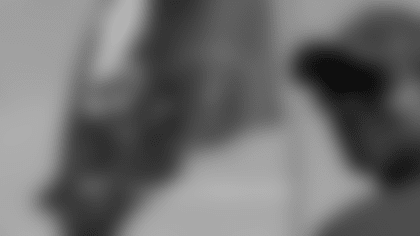The Tampa Bay Buccaneers head into the 2019 season with largely the same group of running backs they had in 2018, but they are expecting to wring far better results from that crew.
The big change in the backfield came last year, when the team moved on from Doug Martin and, two months later, drafted USC's Ronald Jones early in the second round. Martin had already ceded his starting job to Peyton Barber, an ascending player who originally arrived as an undrafted free agent, and the addition of Jones was supposed to create a productive one-two punch of power and speed.
Though some of it was due to game situations – mostly, too many early and big scoreboard deficits – Tampa Bay's ground game never got into any sort of groove, and the timeshare of Barber and Jones certainly did not materialize. The Buccaneers produced the most yards in the league through the air but weren't able to complement that with a strong rushing attack.
The Bucs also didn't stack up many wins, and as a result a coaching change followed the end of the 2018 season. Bruce Arians and his staff aided General Manager Jason Licht in the sort of roster reshaping one would expect from a team with a new coach, but the more sweeping changes have come on the defensive side of the ball. Arians has taken several opportunities to praise Barber and Licht has said he expects much bigger things from Jones in his second year after a washout of a rookie campaign.
Those roster changes are mostly complete now that the draft is in the past and free agency is in its latter stages. Once they officially sign a group of undrafted free agents, the Buccaneers will likely be at or near the 90-man offseason roster limit. There will likely be a few tweaks to that roster between now and training camp, but the group the Bucs will take into that camp is mostly now set. As such, we are taking a position-by-position look to see how things have changed and where the Bucs stand at each corner of the depth chart heading into the new season.
On Monday we examined the quarterbacks. Now we'll move on to their offensive backfield mates: Running Backs.
Addition(s): Andre Ellington (free agent), Kerwynn Williams (free agent)
Subtraction(s): Jacquizz Rodgers (unrestricted free agent, not re-signed)
Returning Players: Peyton Barber, Ronald Jones, Dare Ogunbowale* , Shaun Wilson*
(* Ogunbowale was on the practice squad and Wilson was on injured reserve at the end of the 2018 season.)
Again, the Buccaneers are returning that hopeful 1-2 combo of Barber and Jones but the man who actually spelled Barber most often has moved on. That would be Jacquizz Rodgers, who played 368 snaps on offense in 2018 to 90 for Jones. Obviously, Jones would eat up some of those available reps if he does indeed come on strong in his second year, but there is still room for another back or two in the mix.
As of Wednesday morning, that competition consisted of two young, returning players and two more seasoned veterans who previously worked with Arians in Arizona. There may be another back or two in the mix when the Buccaneers officially sign this year's group of undrafted free agents.
The two returners are Dare Ogunbowale and Shaun Wilson, a pair of former undrafted free agents who got their first taste of NFL regular-season action last year, albeit a relatively limited dose. Wilson got into five games before landing on injured reserve; Ogunbowale played in two later-season contests. Both briefly possessed the kickoff return job, and that very thing could help them keep a foot in the roster door in 2019.
The two newcomers are new to Tampa but not Arians. Both Andre Ellington and Kerwynn Williams last saw regular-season action under Arians with the Cardinals in 2017. Both were essentially there for most of Arians' five-year run in the desert, filling complementary roles and putting up some nice numbers in the process. Ellington had the most robust receiving numbers of the two and should get a crack at competing for the third-down job. Williams had a nice 4.5-yard per-carry average and had a stint as the primary ballcarrier for about a third of the season in 2017.
Still, it's clear that the Bucs are banking on getting more out of the Barber-Jones duo. Barber was the Bucs' starter and leading rusher in 2018, gaining 871 yards and scoring five times but averaging 3.7 yards per carry. The Bucs would like to get that average up in 2019 but do like Barber's consistency, power and effort.
"The tape really makes me have no worries when I watch Peyton play, to be honest with you," said Offensive Coordinator Byron Leftwich. "The tape says a lot of good stuff. He's a phone booth guy, knows how to make guys miss, drop his shoulder. May not be the fastest guy, but he's a runner with the football and it's more important that when you turn around to hand that football up, you're giving it to a runner, not a specific fast guy. He sees it as well, he makes the right cuts, so I'm perfectly fine with having Peyton in."
Jones did not find a role in the Bucs' 2018 offense to start the season and when he did get his opportunities they were relatively brief and rarely productive. He finished with just 23 carries for 44 yards, plus seven receptions for 33 yards. The Bucs think they can unlock the big-play potential in Jones that was so evident at USC and made him the 38th pick in the 2018 draft.
"We've got some guys that can do something with the football," said Leftwich. "Guys like RoJo haven't had a lot of real opportunities. I know around the league that group may not be looked highly at around the league, but I like where we are at, to be honest with you. I like what Peyton brings."
Notable 2018 Numbers: Tampa Bay's average of 95.2 rushing yards per game was fourth-worst in the NFL in 2018, but of a greater concern was the 3.92 yards per carry that put the Bucs second-to-last. The Buccaneers' running backs, in particular, combined to post 3.5 yards per carry.
The Buccaneers would obviously like more big plays in their rushing attack but the first order of business is to get it back to an every-down reliability.
"Four or more, used to be [our] thing," said Running Backs Coach Todd McNair, remembering his days as a running back in Kansas City, with Arians as his position coach. "Just find four yards. When you're averaging four yards a carry your offense is efficient. Find your four and more will come."
The Bucs need opposing offenses to respect their rushing attack in order to give more bite to the play-action passing game. Arians' "no risk it, no biscuit" approach means the Bucs will likely throw the ball downfield more often in 2019 and those plays have a better chance of success if good play fakes are pulling the safeties forward toward the line of scrimmage.
"Obviously here in the past, from what I've been told, the running game hasn't been that great," said Run Game Coordinator Harold Goodwin. "We have to improve that. Without the running game I don't think you can do much in the passing game because we've got to set up the play-action pass just by being able to run it."
Tampa Bay's offense was very good at converting third downs in 2018, ranking third in the league with a 46.0% success rate. That wasn't because the Bucs were particularly good at creating shorter third downs, however; rather, the passing attack was just very adept at mid-range passing. The Bucs averaged 7.7 net yards per pass attempt, second-best in the NFL. Their third-down work could get even better with shorter attempts; the Buccaneers were 31st in rushing average on first down and 32nd on second down.
If the Buccaneers can approve on that down-to-down consistency and find a greater number of big plays in the ground game it will be an enormous improvement from last year. Tampa Bay's running backs combined to record five carries of 20 or more yards in 2018, the lowest total for any team in the NFL.
Key Question: Can Ronald Jones be the one to provide those aforementioned big plays?
The Buccaneers' new coaches clearly believe in Peyton Barber as a running back who can grind out an efficient rushing attack, finding the lane quickly, hitting it hard and usually pushing forward for extra yardage after contact. And indeed, there doesn't seem to be much question that Barber, who has improved every season, can be a workhorse back. They are hopeful that Jones can hit the home runs to complement Barber, and that's obviously less of a sure thing.
The Bucs drafted Jones a year ago after he averaged 6.1 yards per carry over three seasons at USC, scored 42 touchdowns and racked up more than 1,700 yards from scrimmage in 13 games as a junior. He didn't have enormous pass-catching numbers for the Trojans, with 32 catches over three years, but he averaged 13.4 yards per grab as a junior and the Bucs believed he could break some long ones if he got the ball out in space.
Unfortunately, Jones didn't find a lot of space in the early going and that may have slowed down his NFL momentum.
"RoJo had 23 carries on the season and 13 of those he got hit at or behind the line of scrimmage," said McNair. "So the biggest thing with him is restoring his confidence. Once we start getting him to the second level clean… A guy comes out of college, USC's a high-profile program, second-round draft pick and he doesn't have a lot of success, I've seen that happen before. His confidence can wane a bit. For him it's working on his approach, learning how to be a pro."
Jones' seven catches last year came on just nine targets, which is a pretty good catch rate, but he didn't always look fluid in practice in that part of his game. Jones is a fluid athlete, however, and McNair thinks he can help the young back improve significantly in that part of the game by focusing on his hands.
"What I notice with him, I think the biggest thing with him is hand placement," said McNair. "He does some funky things with his hands. From a catching-technique standpoint he's got some funny stuff. Somewhere along the line I learned a game to help with hand placement, that he can start to build the muscle memory of how to place your hands."
McNair would seem to be a good mentor in this regard. He played under Arians at Temple in the late '80s and posted modest pass-catching numbers. He never had more than 19 catches in a season and finished with a four-year total of 45. McNair got to Kansas City and immediately racked up 34 receptions for 372 yards as a rookie, followed by four more seasons in which he surpassed 35 catches. And, indeed, McNair says his work with Jones on catching the ball is already paying off, with the second-year back dropping a couple passes at the beginning of Phase 2 of the offseason program (when coaches can start working with players on the field) but none in recent weeks.
The Buccaneers brought in some running backs with knowledge of Arians' offense and some past NFL success, but they didn't otherwise use free agency or the draft to add a major piece to the backfield. That means that if they hope to find a homerun hitter in that group their best bet will be helping Ronald Jones have a breakout second season.























